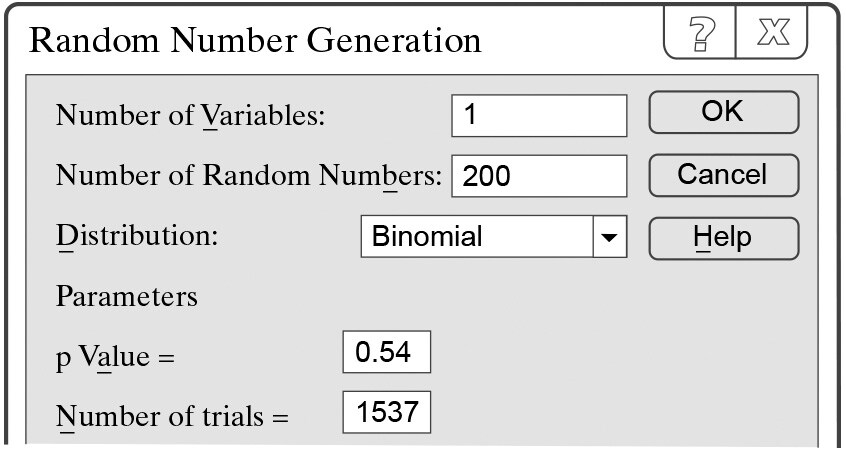Bisexual Idenfitication In a survey of 692 lesbian, gay, bisexual, or transgender U.S adults, 378 said that they consider themselves bisexual. Construct a 90% confidence interval for the population proportion of lesbian, gay, bisexual, or transgender U.S. adults who consider themselves bisexual. (Adapted from Gallup)
Table of contents
- 1. Intro to Stats and Collecting Data1h 14m
- 2. Describing Data with Tables and Graphs1h 55m
- 3. Describing Data Numerically2h 5m
- 4. Probability2h 16m
- 5. Binomial Distribution & Discrete Random Variables3h 6m
- 6. Normal Distribution and Continuous Random Variables2h 11m
- 7. Sampling Distributions & Confidence Intervals: Mean3h 23m
- Sampling Distribution of the Sample Mean and Central Limit Theorem19m
- Distribution of Sample Mean - Excel23m
- Introduction to Confidence Intervals15m
- Confidence Intervals for Population Mean1h 18m
- Determining the Minimum Sample Size Required12m
- Finding Probabilities and T Critical Values - Excel28m
- Confidence Intervals for Population Means - Excel25m
- 8. Sampling Distributions & Confidence Intervals: Proportion1h 25m
- 9. Hypothesis Testing for One Sample3h 57m
- 10. Hypothesis Testing for Two Samples4h 50m
- Two Proportions1h 13m
- Two Proportions Hypothesis Test - Excel28m
- Two Means - Unknown, Unequal Variance1h 3m
- Two Means - Unknown Variances Hypothesis Test - Excel12m
- Two Means - Unknown, Equal Variance15m
- Two Means - Unknown, Equal Variances Hypothesis Test - Excel9m
- Two Means - Known Variance12m
- Two Means - Sigma Known Hypothesis Test - Excel21m
- Two Means - Matched Pairs (Dependent Samples)42m
- Matched Pairs Hypothesis Test - Excel12m
- 11. Correlation1h 24m
- 12. Regression1h 50m
- 13. Chi-Square Tests & Goodness of Fit2h 21m
- 14. ANOVA1h 57m
8. Sampling Distributions & Confidence Intervals: Proportion
Confidence Intervals for Population Proportion
Problem 6.Tech.3b
Textbook Question
Since 1935, the Gallup Organization has conducted public opinion polls in the United States and around the world. The table shows the results of Gallup’s World Affairs Poll of 2021, in which 1021 U.S. adults were polled. The remaining percentages not shown in the results are adults who were not sure.

b. What was the greatest value you obtained for p^?
 Verified step by step guidance
Verified step by step guidance1
Step 1: Understand the problem. The question asks for the greatest value of p^ (sample proportion) obtained from the Gallup World Affairs Poll of 2021. The image provides parameters for a binomial distribution simulation, which can help analyze probabilities or proportions.
Step 2: Recall the formula for the sample proportion p^: p^ = x/n, where x is the number of successes and n is the total number of trials. In this case, n = 1021 (the number of U.S. adults polled).
Step 3: Analyze the image. The Random Number Generation tool is set to simulate a binomial distribution with p = 0.54 (probability of success) and 1537 trials. However, this simulation is unrelated to the actual poll data, which involves 1021 adults. Focus on the poll data for calculating p^.
Step 4: To find the greatest value of p^, identify the category with the highest number of successes (x) from the poll data. If the data is not explicitly provided, assume the highest percentage corresponds to the greatest p^.
Step 5: Calculate the greatest p^ using the formula p^ = x/n, where x corresponds to the highest percentage of responses multiplied by n (1021). Ensure to convert the percentage into a decimal before multiplying.
 Verified video answer for a similar problem:
Verified video answer for a similar problem:This video solution was recommended by our tutors as helpful for the problem above
Video duration:
2mPlay a video:
Was this helpful?
Key Concepts
Here are the essential concepts you must grasp in order to answer the question correctly.
Proportion Estimate (p^)
The proportion estimate, denoted as p^ (p-hat), represents the sample proportion of a certain characteristic in a population. It is calculated by dividing the number of successes (individuals with the characteristic) by the total number of observations in the sample. In the context of polling, p^ indicates the percentage of respondents who expressed a particular opinion.
Recommended video:
Guided course

Difference in Proportions: Confidence Intervals
Binomial Distribution
The binomial distribution is a probability distribution that describes the number of successes in a fixed number of independent Bernoulli trials, each with the same probability of success. It is characterized by two parameters: the number of trials (n) and the probability of success (p). This distribution is useful for modeling scenarios like polling, where outcomes can be classified as success or failure.
Recommended video:
Guided course

Mean & Standard Deviation of Binomial Distribution
Random Sampling
Random sampling is a technique used to select a subset of individuals from a larger population, ensuring that each individual has an equal chance of being chosen. This method helps to obtain a representative sample, which is crucial for making valid inferences about the population. In the context of the Gallup poll, random sampling ensures that the opinions of the 1021 U.S. adults reflect the broader population's views.
Recommended video:

Simple Random Sampling

 5:45m
5:45mWatch next
Master Constructing Confidence Intervals for Proportions with a bite sized video explanation from Patrick
Start learningRelated Videos
Related Practice
Textbook Question
26
views
